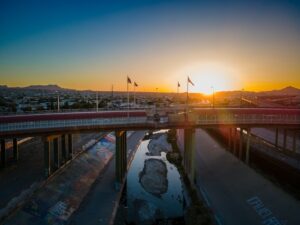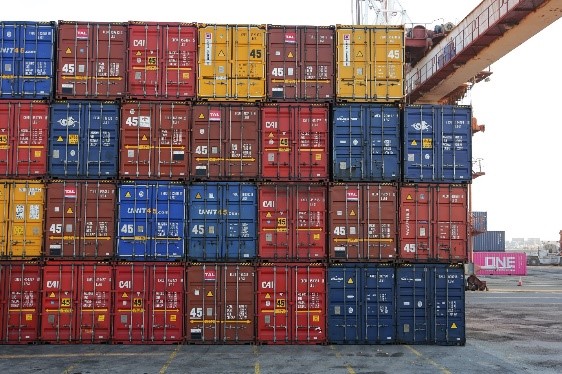El Paso Port of Entry to the United States by Jacob Wenzel

The city demographics of El Paso are unique. Approximately 680,000 people live in the El Paso metro area making it the fifth-lar
gest city in Texas. Nearly 85% of people living in El Paso as permanent residents are Hispanic. Thousands of people cross the border between El Paso and its sister city of Ciudad Juarez daily. The ease and frequency of individuals who travel between the two cities have somewhat blurred the lines between where Mexico ends and where the US begins.
The sister city of Juarez resides in the Mexican state of Chihuahua. The state is the fifth largest in Mexico in terms of its manufacturing GDP and also receives some of the highest levels of foreign investment in all of Mexico. In terms of manufacturing the state produces goods in the automotive, aerospace, and medical industries. In addition to these industries, the state also has some of the largest mining operations in Mexico. Some unique industries of Chihuahua are its robust livestock and agriculture industries. While Chihuahua received its namesake from the Chihuahua desert the statehas a climate that is beneficial for agriculture. The state is a leader in the production of cotton, walnuts,
apples, oats, and chilis. Due to the state’s proximity to the U.S., it has the role of facilitating the transport of this commerce to the U.S., an industry that generates billions of dollars for its economy.
The history between the cities of El Paso and Juarez is deeply connected and the roots of their relationship dates back nearly three centuries. Among the modern highways and metal fences that run along the El Paso port of entry, you can see remnants of how people used to traverse the U.S.-Mexico border before the creation of sanctioned ports of entry. Large rickety bridges and decrepit railroads of the past can be seen almost anywhere you look. Some of the bridges have been in these locations for more than 250 years. The long-standing relationship between the two cities has become increasingly important as many people from Juarez rely on jobs that they can get in El Paso to provide for their families in Mexico. The high demand for efficient transit between the two cities required the federal government to create four main border crossings to facilitate pedestrian, commercial, and non-commerce traffic to cross the border with ease.
The four main crossing points are the Ysleta-Zaragoza Bridge, the Bridge of the Americas, the Stanton Street Bridge, and the Paso del Norte Bridge. All four of the crossing points connect the city of El Paso to the city of Juarez located in the Mexican state of Chihuahua. These crossing points are extremely important to the citizens living in both cities but each is unique in the services provided for the people who use them every day.
The Ysleta-Zaragoza Bridge and the Bridge of the Americas should be described in tandem as they are the only crossings out of the four that receive both commercial and noncommercial foot traffic at a very high rate. The Ysleta-Zaragoza bridge is an international bridge that connects El Paso and Juarez crossing directly over the Rio Grande river. The original bridge was deteriorating until the present bridge was erected in 1990. The present-day bridge dwarfs its predecessor as the current bridge consists of two main structures. The first is a four-lane facility that receives all of the commercial traffic with products that have come from all across Mexico. The second structure is a five-lane bridge used solely for noncommercial pedestrian traffic. This bridge is where millions of people cross the border each day to work in either El Paso or Juarez. The Bridge of the Americas is similar to the Ysleta-Zaragoza bridge as it also receives both commercial and noncommercial traffic, but that is where the similarities end. The Bridge of the Americas otherwise known as “Puente Libre” or “Free Bridge” is a group of international bridges that cross the Rio Grande and connect to Texas State Highway 375. The structure consists of four bridges, two of which are for truck traffic and the other two are for passenger vehicles with additional sidewalks for pedestrians. The bridge was built by the International Boundary and Water Commission in 1996 and is operated by both U.S. and Mexican customs respectively. The bridge has received the nickname “Free Bridge” because it is the only international bridge entering the U.S. that does not have a toll.
The Stanton Street Bridge and the Paso Del Norte Bridge are similar because they primarily receive pedestrian/noncommercial traffic. The Stanton Street Bridge otherwise known as the “Good Neighbor Bridge” was completed in 1967. It is a five-lane bridge with three lanes of traffic solely for pedestrian use only. The Paso Del Norte is also a noncommercial bridge but the scale at which it operates dwarfs all other ports of entry in the El Paso area. The El Paso del Norte Port of Entry is among the busiest border crossings between the US and Mexico. It is so busy that almost 10 million people will cross through this port of entry per year. Only the San Ysidro Port of Entry in San Diego, California has more people crossing it per year. While both of these ports of entry are somewhat simple and smaller when compared to their commercially focused counterparts the value that they bring cannot be understated. Both bridges combined bring in tens of millions of people into the US every year with some establishing permanent residency and others just working day by day in the city of El Paso.
About the Author
Jacob Wenzel graduated from the University of San Diego with a degree in both Political Science and International Business.
He participated in a study abroad opportunity in Tokyo, Japan where he studied the international business practices of many Asian countries. This trip established Jacob’s love for travel and no matter where his work takes him he is excited to learn more about where he will end up. Outside of school, Jacob has worked at several law firms and political campaigns as well as other jobs like a local pizza shop in San Diego. Jacob wants to explore the international business world further before applying to law school later in the future.



